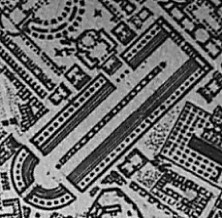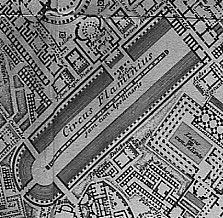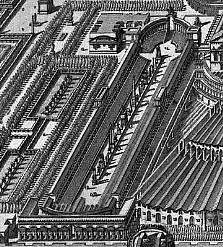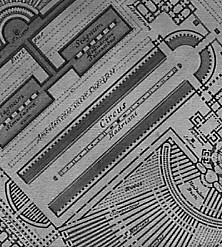more on language
2000.12.13
...when you say/ask: "I was (and remain) concerned in the present context simply to ask whether there are any arguments for (a language of architecture--that is, something construed in terms of the primary components of language (syntax, semantics, pragmatics) and attendant accounts of the phenomenology, originary foundations, physical characteristics, and so forth.) that go beyond appeals to a metaphorical sense of 'language'. I haven't come across any, and so I appeal to the list to see if anyone else has," I admit to not being entirely sure what it is that you're after, but that may be because I have yet to re-read prior posts. In any case, your question made me think of Tafuri's criticism of Piranesi's Ichnographia Campus Martius where he states (in The Sphere and the Labyrinth, p. 38):
The ambiquity of the Campo Marzio now becomes evident; it is at once a "project" and a denunciation. As a disenchanted documentation of the impossibility of an unambiguous definition of language, it--projecting this situation into the past--sounds like a merciless satire of the infinite capacity of late-baroque typology to reproduce itself metamorphically. (The fact that in the Campo Marzio the allusion to baroque typologies is filtered through a classicist geometrism fools no one; it is simply a means of rendering metahistorical and universal the polemic already begun.) Inasmuch as it is--despite everything--an affirmation of a world of forms, the Campo Marzio, precisely because of the absurdity of its horror vacui, becomes a demand for language, a paradoxical revelation of its absence.
Negation and affirmation cannot split apart. The "na´ve dialectic" of the Enlightenment is already superseded.
The "great absentee" from the Campo Marzio, then, is language.
The absolute disintegration of formal order, of what remained of the humanist Stimmung, of its sacred and symbolic values--and, above all, of perspective as a symbolic instrument for the quantitative control of space--logically also affects the subject of Piranesi's work: the relationship between history and the present.
I interpret the above to mean that Tafuri believes the Campo Marzio cannot be coherently read or understood because, as Tafuri sees it, Piranesi presents something like xenoglossy (i.e., a trance state of a language unknown to the individual under normal conditions). Over the past several years I've been doing a lot of research and writing whereby I essentially prove Tafuri wrong in that Piranesi's large plan of the Campo Marzio can indeed be read, and, moreover, the plan is a very sophisticated double narrative telling the story of both Pagan and Christian Rome. Piranesi in fact utilizes two languages: Latin (for labeling buildings) and an architectural language of planimetrics.
As far as I know, Piranesi's Ichnographia Campus Martius is the only example of a historical narrative that is delivered not by spoken or written language and/or pictorial illustration, but by a composition of architectural plans and their labels. If that is the case, then Piranesi's large plan is indeed a rare document where architecture is the language used to communicate a (very long) story.
back to the Campo Marzio
2001.09.08 16:50
Hello John,
...getting back to the two states of the Ichnographia, here are some further thoughts and questions:
1. I believe the first state is the plan as it is NOT published in books today. If you look at the smaller and earlier plans of the Campo Marzio within the plates prior to the Ichnographia, you will see earlier plans of the Circus Flaminius the same as the Circus Flaminus plan within the first state Ichnographia. Furthermore, the aerial view the Circus Hadriani within the frontispiece corresponds in plan with the first state Ichnographia.
 
 
2. I think the circus delineations of the second state (which are all virtually identical to each other) are in fact delineations based on the Circus of Maxentius (rather than the Circus Maximus). This is somewhat significant in that (according to my research and interpretation of the Ichnographia as a double narrative relating Rome's inversion from pagan city to Christian city) Maxentius is exactly the ruler of Rome immediately prior to Constantine's Chistian efforts.
3. ...now knowledgable of the practice of damnatio memoriae, I wonder if Piranesi purposefully 'erased' portions of the Ichnographia as a reenactment of the damnatio memoriae practice, and, like some extant examples of dm inscriptions, if he then purposefully followed up with a palimpsest (of another plan) over the erasure.
4. I realized that I have yet to see an actual print version of the second state of the Ichnographia. All I've ever seen is an actual first state (1761) version. Do you know if you've seen an actual eighteenth cent. print version of the second state? Moreover, did you happen to make a trip to Rome to see which state the actual engraved plates are in? It is the current state of the plates that would surely identify the second state (that is, unless someone long ago altered a reproduction, and it happens to be an altered reproduction that's been printed in books all these years).
5. I also believe that it was indeed Piranesi that made the changes. My main reasoning here is that Piranesi was very likely the only person that could have made the changes with such dexterity.
As to Tafuri, I have documented so many cases within the Ichnographia that carried explicit meaning and message on Piranesi's part, that all of Tafuri's theorizing that the Ichnographia is indicative of and/or percursor to the modern meaninglessness of architectural form is plainly and emphatically wrong. What Tafuri obviouly never did, but definitely should have done, is to translate all the Latin labels that Piranesi applies to virtually all the plans of the Ichnographia. It is only through reading the labels and the planimetrics in combination that the full meaning of Piranesi's Campo Marzio comes through.
All the best,
Steve Lauf
| |
abstract for Studium Urbis
2003.01.19 17:26
Mnemonically Delineating Veracity
"Authenticity is one thing, veracity another."
Marguerite Yourcenar, "Faces of History in the Historia Augusta" in The Dark Brain of Piranesi and Other Essays.
An apparent lack of veracity has always been at issue within modern interpretations G. B. Piranesi's Ichnographia Campi Martii (1757-62) despite Piranesi's extraordinary 'scientific' knowledge of ancient Rome and it's remains as evident throughout the four volumes of Le AntichitÓ Romane (1756), as well as throughout Piranesi's other archaeological publications, including the Il Campo Marzio dell'Antica Roma. Contemporary architectural theorists from historian Manfredo Tafuri to architect Peter Eisenman view the Ichnographia as a city devoid of its own history, thus a plan prognosticating autonomous urbanism, yet that is exactly what the Ichnographia Campi Martii is not.
Beginning with comparisons between select portions of the Piranesi's Ichnographia and Giambattista Nolli's Pianta Grande di Roma, it becomes clear that the Ichnographia is an elaborate mnemonic devise. Like the imaginary building plans that Roman orators created in their minds as an aid toward the memorization of their speeches, the Ichnographia is literally an imaginary plan manifest as an aid toward the memorization of virtually all of ancient Rome's history. Thus the Ichnographia is not a fantastical reconstruction, rather, like the art of memory itself, the Ichnographia is a reenactment.
Mnemonically Delineating Veracity concludes with a brief reenactment of how an independent artist from Philadelphia came to discover a heretofore unnoticed initial(?) printing of the Ichnographia Campi Martii.
cloning architecture - a global search
2004.06.16 05:53
On the Campo Marzio issue, I've (already) compiled a bibliography of architectural literature on Piranesi's large plan. Briefly, before Tafuri there is Fasolo in 1956 (who Tafuri in places reiterates, but he did not note any of the 1956 mistakes), and Scully on Kahn in 1962. Tafuri's Architecture and Utopia was first published in Italian in 1973, and his The Sphere and the Labyrinth was first published in Italian in 1980. Since 1980, most architectural writers have sprouted off the Tafuri branch, and there is only one architectural writer who, in 1981, began to sprout off Kahn's branch of investigation entwined with reenactment.
Koolhaas versus the Actor
2005.05.05 11:08
I just did a very quick scan of "l'architecture dans le boudoir," and it seems a very good reference point, and a very good point of departure for further investigation regarding architecture and reenactment. Taking "l'architecture dans le boudoir" and the non-Tafuri reading of the Campo Marzio plan may indeed deliver heretofore unexpected fruitful results in terms of understanding all the mid-late 20th architecture that Tafuri writes about.
Koolhaas versus the Actor
2005.05.06 17:24
Stirling is a consummate reenactionary architect, and he knew it, but he put most of his clues in his architecture only--although his entry for Roma Interrotta is an overt reference to Piranesi's Campo Marzio plan and reenactionary architecturism. Just as Rossi reenacted the Bustum Hadriani with the Modena Cemetery, but it doesn't look like he ever told Tafuri about it.
Re: clarification
2005.05.08 19:03
First off, I accidentally skipped a paragraph within the passages I sent you earlier today. The missing paragraphs comes after "...Campo Marzio leads to the same conclusion." Here's the paragraph:
The obsessive articulation and deformation of the composition no longer correspond to an ars combinatoria. The clash of the geometric "monads" is no longer regulated by any "preestablished harmony"; and, most important, it demonstrates that the only meaning this paradoxical casuistry can refer back to is pure geometry, in the absolute semantic void that characterizes it.
It seems that Tafuri saw (in the Campo Marzio) individual plans that don't signify anything either historic or symbolic or even realistically typologic, and all together the Ichnographia is heap of meaningless fragments, thus it's all a divorce from any symbolic/meaningful system.
I just read some of Barthes' Elements of Semiology where a sign is composed of a signifier and a signified, and, what Tafuri sees is the Campo Marzio plans (individually and as a 'whole') as signs that still have a signifier, i.e., architectural building plans, but these signs/plans lack a signified, something that gives the plans any real meaning.
In reality, Piranesi employed all kinds of signs that carry a wide variety of signifiers--sometimes it's the shape of the plan(s), sometimes it's the placement/location (rightly or wrongly) of the plan(s), often it's just the label/name attached to the plan (which signify at least some historical existence), and then there are examples of combinations of the above distinctions, e.g., the Atrium Minerva (wisdom) as centerpiece of the 'garden of satire' which is situated at a location coincident with the top of the Spanish Steps, where Piranesi moved his family and business about a years after the Campo Marzio was published.
Anyway, there is so much out there now (especially from Eisenman) regarding this great analysis that Tafuri did, that this may be just the beginning of a great unraveling. Odd, I never imagined that reenactment would be at the center of all this.
In simple terms, Tafuri's work is unfortunately a history that was cooked too quickly, served too quickly, and eaten up too quickly.
|